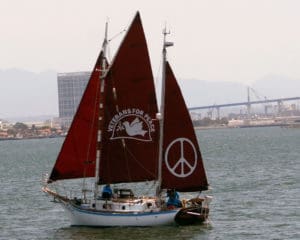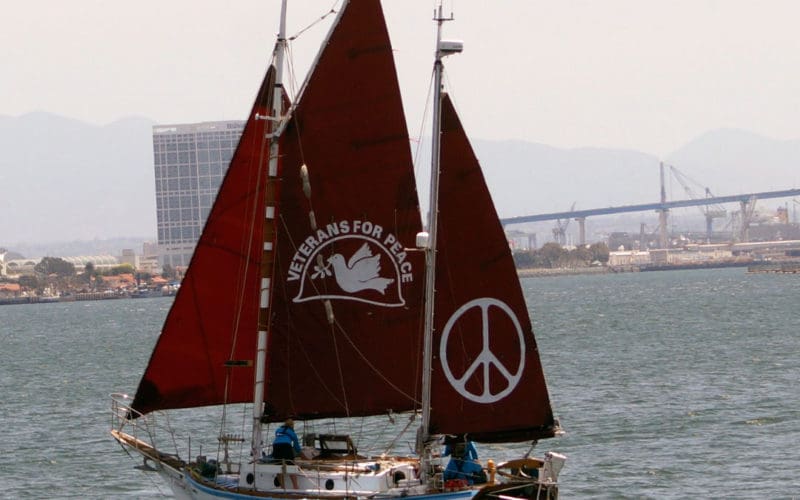It’s a misty day in the photo and the sand is brownish gray, setting off the white paint of the derelict hull as if the boat were lit by a ray of sunshine. She had sunk after being battered by a storm while tied to pilings nearby. No name shows on her transom and her wooden sides are stove in, her insides a mess. Two days later, the boat was hauled out by Leroy Zerlang of Zerlang & Zerlang Marine Services on Humboldt Bay in Northern California. Zerlang specializes in resurrecting wooden boats — and a shipwright said she could be repaired, but renovation is an expensive proposition without a fixed end. Had she been an ordinary yacht, this would have been her end. But this was the sailboat Golden Rule, the first boat to try to sail into an H-bomb testing area to protest nuclear weapons in 1958. Fifty-two years after exiting the known world, Golden Rule had reappeared.
Zerlang knew enough of her history to be intrigued and send out feelers for funding. The call was answered by Veterans for Peace, a group founded in 1985 by U.S. veterans concerned about the global nuclear arms race. Its mission to build “a culture of peace” by nonviolent means fits the beliefs of the Quakers who first sailed Golden Rule.

Based on Sea Witch
Golden Rule is an A-30 Alpha ketch designed and built by Hugh Angelman and Charles Davies in Los Angeles in 1957. The A-30 is a smaller version of Sea Witch, a beamy clipper-bowed, 36-foot, gaff-rigged ketch that won the Transpac race in 1951. The Sea Witch design is still in use in the cruising community, especially on the South Pacific run where the design works well for trade wind sailing. Herb “Dynamite” Payson owned a Sea Witch, about which he wrote his cruising books.
Now, in 2010 Fredy and Sherry Champagne heard about a peace boat having washed ashore and, non-sailors that they were, showed up at Zerlang’s. Fredy, a Vietnam veteran, and Sherry, a musician and artist, are longtime members of the Northern California chapter of Veterans for Peace. When Zerlang agreed to provide the yard space and repair facilities, the Champagnes formed the VFP Golden Rule Project along with Chuck DeWitt, a Navy veteran and the project’s restoration coordinator; Brecken Van Veldhuizen, a young recent graduate of the Northwest School of Wooden Boatbuilding; master shipwright David Peterson; woodworker Mike Gonzalez; welder/metal fabricator Dennis Thompson; and a daily roster of volunteers to help with restoration and fundraising.
Golden Rule was hauled off the sand and set upright where a shed could be built around her. Her frame was repaired with tough American purpleheart and her damaged planks removed to be replaced with Port Orford cedar — a durable, light-colored wood native to the area. Zerlang found two wooden boats to salvage for parts, and the team melted 90 pounds of brass to pour their own rudder fittings and make belaying pins for Golden Rule and to sell as well. In 2012, a local artist painted Golden Rule’s name in the original font on the restored brightwork transom. A 30-hp Yamaha engine was donated and installed. Also in 2012, the yard held a “whiskey plank party” where the final hull plank was screwed in place.
Launched in Humboldt Bay
A new main mast was built from eight 20-foot vertical grain fir planks scarfed to make four 40-foot planks. The mast was put together by a large team of people recruited to mix epoxy, brush it on and clamp the planks together in a square spar that was then shaped, sanded and painted. In June 2015, Golden Rule splashed to great fanfare into Humboldt Bay. The boat was sailed to San Diego in time for the VFP National Convention with a captain, first mate and volunteer crew. Her deck and cove stripe were painted sky blue and her red sails emblazoned with peace symbols and the VFP logo. They invited people for tours at stops and partnered with local peace activist groups to educate the public. As Chuck DeWitt said, she became “a weapon of mass education.”
Fears of a new nuclear arms race fed by small smart weapons, in addition to the group’s reaction to the Fukushima nuclear plant accident, spurred the group to enlarge Golden Rule’s mission. In 2018, VFP started planning to send her back across the Pacific, first to Honolulu (where her original crew were jailed in 1958 to prevent them from reaching the H-bomb test zone in the Marshall Islands), then on to the Marshalls, Guam, Okinawa and Japan in time for the 75th commemoration of the atomic bombing of Hiroshima.
Golden Rule has made it to Honolulu and, according to project manager Helen Jaccard, has reached funding goals for sailing to the western Pacific but will have to wait for coronavirus to work its course. When it does, you can watch Golden Rule’s progress on share.garmin.com/goldenrule. If interested, you can look into being a crewmember, and the project always needs funding help — especially now, with the unforeseen costs of staying in Hawaii. The project has produced an excellent documentary film, which is at the project’s website, www.vfpgoldenruleproject.org.
Albert Bigelow, a Quaker Navy captain in WWII and the boat’s first skipper, realized the way to get to an island nuclear testing zone was by small boat. Today, like then — as he wrote in his book, The Voyage of the Golden Rule: An Experiment with Truth — the idea is to send a “tiny white sail slowly westward to blow the horrid deed in every eye. The act would speak louder than words.”
—Ann Hoffner voyaged with husband Tom Bailey aboard their Peterson 44, Oddly Enough.

